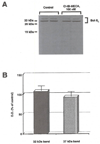The A3 adenosine receptor mediates cell spreading, reorganization of actin cytoskeleton, and distribution of Bcl-XL: studies in human astroglioma cells
- PMID: 9425266
- PMCID: PMC4248308
- DOI: 10.1006/bbrc.1997.7705
The A3 adenosine receptor mediates cell spreading, reorganization of actin cytoskeleton, and distribution of Bcl-XL: studies in human astroglioma cells
Abstract
The pathophysiological role of the adenosine A3 receptor in the central nervous system is largely unknown. We have investigated the effects of the selective A3 receptor agonist 2-chloro-N6-(3-iodobenzyl)-adenosine, Cl-IB-MECA, in cells of the astroglial lineage (human astrocytoma ADF cells). A marked reorganization of the cytoskeleton, with appearance of stress fibers and numerous cell protrusions, was found following exposure of cells to low (nM) concentrations of Cl-IB-MECA. These "trophic" effects were accompanied by induction of the expression of Rho, a small GTP-binding protein, which was virtually absent in control cells, and by changes of the intracellular distribution of the antiapoptotic protein Bcl-XL, that, in agonist-exposed cells, became specifically associated to cell protrusions. This is the first demonstration that the intracellular organization of Bcl-XL can be modulated by the activation of a G-protein-coupled membrane receptor, such as the A3 adenosine receptor. Moreover, modulation of the astrocytic cytoskeleton by adenosine may have intriguing implications in both nervous system development and in the response of the brain to trauma and ischemia.
Figures





References
-
- Rudolphi KA, Schubert P. In: Novel Therapies for CNS Injuries: Rationales and Results. Peterson PL, Phillis JW, editors. 1996. pp. 327–346.
Publication types
MeSH terms
Substances
Grants and funding
LinkOut - more resources
Full Text Sources
Other Literature Sources
Research Materials

